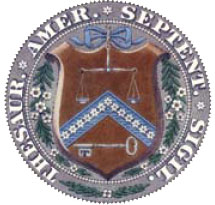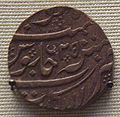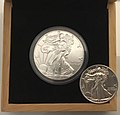Portal:Numismatics
The Numismatics Portal

Numismatics is the study or collection of currency, including coins, tokens, paper money, medals, and related objects.
Specialists, known as numismatists, are often characterized as students or collectors of coins, but the discipline also includes the broader study of money and other means of payment used to resolve debts and exchange goods.
The earliest forms of money used by people are categorised by collectors as "odd and curious", but the use of other goods in barter exchange is excluded, even where used as a circulating currency (e.g., cigarettes or instant noodles in prison). As an example, the Kyrgyz people used horses as the principal currency unit, and gave small change in lambskins; the lambskins may be suitable for numismatic study, but the horses are not.[dubious – discuss] Many objects have been used for centuries, such as cowry shells, precious metals, cocoa beans, large stones, and gems. (Full article...)
Selected article -

Banknotes of Scotland are the banknotes of the pound sterling that are issued by three Scottish retail banks (Bank of Scotland, the Royal Bank of Scotland and Clydesdale Bank) and in circulation in Scotland. The Bank of Scotland, the oldest bank operating in the country, was the first bank in Europe to successfully print its own banknotes in 1695. The issuing of banknotes by retail banks in Scotland is subject to the Banking Act 2009, which repealed all earlier legislation under which banknote issuance was regulated, and the Scottish and Northern Ireland Banknote Regulations 2009. Currently, three retail banks are allowed to print notes for circulation in Scotland: Bank of Scotland, Royal Bank of Scotland, and Clydesdale Bank.
Scottish banknotes are unusual, as they are issued by retail banks (not government central banks) and because they are not legal tender in the United Kingdom. They are also not legal tender in Scotland, where, in law, no banknotes (including those issued by the Bank of England) are defined as legal tender. Formally, they are classified as promissory notes, and the law requires that the issuing banks hold a sum of Bank of England banknotes or gold equivalent to the total value of notes issued. (Full article...)
Selected image
Credit: Okerele
Did you know...

- ...that with its two-dollar coin (reverse pictured), Newfoundland was the only British colony to issue circulating gold coinage?
- ...that Mount Burgess is nicknamed the Ten Dollar Mountain because it was featured on Canadian currency?
- ...that the American Buffalo gold bullion coin was the first .9999 fine 24-carat gold coin released by the United States Mint?
- ...that the Alabama centennial half dollar was the first commemorative coin minted with the image of a living individual?
- ...that Aksumite currency was the only native coinage to be issued in Africa without direct influence by an outside culture like Roman, Greek, etc...?
Related portals
Selected coin -

The Florentine florin was a gold coin (in Italian Fiorino d'oro) struck from 1252 to 1533 with no significant change in its design or metal content standard during that time.
It had 54 grains (3.499 grams, 0.1125 troy ounces) of nominally pure or 'fine' gold with a purchasing power difficult to estimate (and variable) but ranging according to social grouping and perspective from approximately 140 to 1,000 modern US dollars. The name of the coin comes from the Giglio bottonato (it), the floral emblem of the city, which is represented at the head of the coin. (Full article...)
Selected banknote image -

Credit: commons:User:Schutz.
A 1000 Swiss franc note, the fourth highest non-commemorative banknote in the world.
General images -
Numismatic terminology
- Bullion – Precious metals (platinum, gold and silver) in the form of bars, ingots or plate.
- Error – Usually a mis-made coin not intended for circulation, but can also refer to an engraving or die-cutting error not discovered until the coins are released to circulation. This may result is two or more varieties of the coin in the same year.
- Exonumia – The study of coin-like objects such as token coins and medals, and other items used in place of legal currency or for commemoration.
- Fineness – Purity of precious metal content expressed in terms of one thousand parts. 90% is expressed as .900 fine.
- Notaphily – The study of paper money or banknotes.
- Scripophily – The study and collection of stocks and Bonds.
WikiProjects
Numismatic topics
Money - Coins - Banknotes - Electronic money - Exchange rate - Legal tender - Clubs - Terminology
Ancient currency: Asia - Byzantium - Greece - Primitive Money - Roman - Indian coinage
Modern currency: Africa - The Americas - Asia and the Pacific - Europe - Bullion coins - Challenge coin - Commemorative coins - Token coins
Economics: Banking - Bonds - Cheques - Credit Cards - Fiat currency - Gold standard - Mints - Monetary union - Reserve currency - Stocks
Production: Coining (machining) - Designers - Die making - Mint (coin) • Coinage Metals: Aluminum - Bronze - Copper - Gold - Platinum - Silver - Tin
Subcategories
Most traded currencies
| Currency | ISO 4217 code |
Proportion of daily volume | Change (2022–2025) | |
|---|---|---|---|---|
| April 2022 | April 2025 | |||
| U.S. dollar | USD | 88.4% | 89.2% | |
| Euro | EUR | 30.6% | 28.9% | |
| Japanese yen | JPY | 16.7% | 16.8% | |
| Pound sterling | GBP | 12.9% | 10.2% | |
| Renminbi | CNY | 7.0% | 8.5% | |
| Swiss franc | CHF | 5.2% | 6.4% | |
| Australian dollar | AUD | 6.4% | 6.1% | |
| Canadian dollar | CAD | 6.2% | 5.8% | |
| Hong Kong dollar | HKD | 2.6% | 3.8% | |
| Singapore dollar | SGD | 2.4% | 2.4% | |
| Indian rupee | INR | 1.6% | 1.9% | |
| South Korean won | KRW | 1.8% | 1.8% | |
| Swedish krona | SEK | 2.2% | 1.6% | |
| Mexican peso | MXN | 1.5% | 1.6% | |
| New Zealand dollar | NZD | 1.7% | 1.5% | |
| Norwegian krone | NOK | 1.7% | 1.3% | |
| New Taiwan dollar | TWD | 1.1% | 1.2% | |
| Brazilian real | BRL | 0.9% | 0.9% | |
| South African rand | ZAR | 1.0% | 0.8% | |
| Polish złoty | PLN | 0.7% | 0.8% | |
| Danish krone | DKK | 0.7% | 0.7% | |
| Indonesian rupiah | IDR | 0.4% | 0.7% | |
| Turkish lira | TRY | 0.4% | 0.5% | |
| Thai baht | THB | 0.4% | 0.5% | |
| Israeli new shekel | ILS | 0.4% | 0.4% | |
| Hungarian forint | HUF | 0.3% | 0.4% | |
| Czech koruna | CZK | 0.4% | 0.4% | |
| Chilean peso | CLP | 0.3% | 0.3% | |
| Philippine peso | PHP | 0.2% | 0.2% | |
| Colombian peso | COP | 0.2% | 0.2% | |
| Malaysian ringgit | MYR | 0.2% | 0.2% | |
| UAE dirham | AED | 0.4% | 0.1% | |
| Saudi riyal | SAR | 0.2% | 0.1% | |
| Romanian leu | RON | 0.1% | 0.1% | |
| Peruvian sol | PEN | 0.1% | 0.1% | |
| Other currencies | 2.6% | 3.4% | ||
| Total[a] | 200.0% | 200.0% | ||
References
- ^ Triennial Central Bank Survey Foreign exchange turnover in April 2025 (PDF) (Report). Bank for International Settlements. 30 September 2025. p. 14. Archived (PDF) from the original on 2025-10-12.
Web resources
- NumisWiki
- International Association of Professional Numismatists
- American Numismatic Association
- American Numismatic Society
- British Numismatic Association
- American Vecturist Association
- Challenge Coin Association
- Numismatic Museum of Athens, Greece
- The Perth Mint Australia
- Central Mint of China
- Royal Mint
- The French Mint
- United States Mint
- Bank of Russia
- Royal Canadian Mint
- Exact Change numismatic software
Things you can do
|
|
 |
Here are some tasks awaiting attention:
|
Associated Wikimedia
The following Wikimedia Foundation sister projects provide more on this subject:
-
Commons
Free media repository -
Wikibooks
Free textbooks and manuals -
Wikidata
Free knowledge base -
Wikinews
Free-content news -
Wikiquote
Collection of quotations -
Wikisource
Free-content library -
Wikiversity
Free learning tools -
Wiktionary
Dictionary and thesaurus
Sources
- ^ The total sum is 200% because each currency trade is counted twice: once for the currency being bought and once for the currency being sold. The percentages above represent the proportion of all trades involving a given currency, regardless of which side of the transaction it is on.




































![Image 24Chinese round coins, Eastern Zhou dynasty – Warring States Period, c. 300–220 BC. Four Hua (四化, 30mm, 6.94 g). Legend Yi Si Hua ([City of] Yi Four Hua). (from Coin)](http://upload.wikimedia.org/wikipedia/commons/thumb/f/f9/CHINA%2C_Eastern_Zhou_dynasty_-_Warring_States_Period._State_of_Q%C3%AD._City_of_Yi._Circa_300-220_BC.jpg/120px-CHINA%2C_Eastern_Zhou_dynasty_-_Warring_States_Period._State_of_Q%C3%AD._City_of_Yi._Circa_300-220_BC.jpg)












































